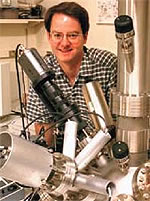Date
Cost
Free and open to the public
Location
Research Pavilion, Room 475 (NanoScience Technology Center)
Description
Time-of-flight secondary ion mass spectrometry (ToF-SIMS) is emerging as a valuable new tool for studies of cultural heritage objects including fine art paintings, especially when used in conjunction with established analytical techniques in the field. ToF-SIMS has the ability to provide chemical-based images of organic and inorganic species within a paint cross-section at micrometer-scale spatial resolution. Two major problems in art conservation and restoration are a lack of understanding of the mechanisms of pigment and binder alteration, and pigment-binder interactions. ToF-SIMS’s high sensitivity and surface sensitivity compared to traditional x-ray techniques provides the benefits of identification and localization of the presence of high- and low-concentration species and their potential roles in pigment and binder alteration. In this talk, we will show how ToF-SIMS was used to detect and image both molecular and elemental species related to CdS pigment and binding-medium alteration on Henri Matisse’s masterpiece painting Le Bonheur de vivre (1905-1906, The Barnes Foundation, Philadelphia). Three categories of inorganic and organic components were found throughout Le Bonheur de vivre and co-localized in cross-sectional samples using ToF-SIMS analysis: (1) species relating to the preparation and photo-induced oxidation of CdS yellow pigments (2) varying amounts of long-chain fatty acids present in both the paint and primary ground layer and (3) specific amino acid fragments, possibly relating to the painting’s complex restoration history.
Presenter

Thomas P. Beebe, Jr., Ph.D.
Professor of Chemistry and Biochemistry
Director, Surface Analysis Facility
Department of Chemistry and Biochemistry
University of Delaware